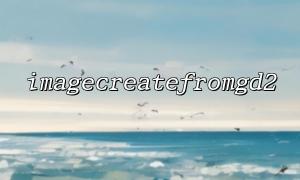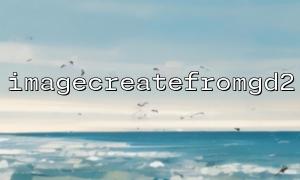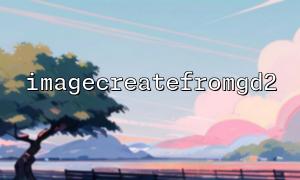In daily development, image processing is a very common requirement, including tasks such as thumbnail creation, watermark addition, and format conversion. In PHP, the GD library provides comprehensive support for image processing, with the imagecreatefromgd2() function used to create an image resource from a .gd2 format file. Although the .gd2 format is not common, by leveraging this function alongside other GD library functions, we can build a general-purpose image processor that supports multiple image formats such as JPG, PNG, GIF, and GD2.
imagecreatefromgd2() is a function within PHP’s GD library, designed to create an image resource from a GD2 format image file:
resource imagecreatefromgd2(string $filename)
GD2 is an image format supported by the GD library itself, primarily used for efficient image storage. Although it is not popular, its support remains useful for certain specific systems or requirements.
We can create a factory function that automatically calls the appropriate creation function based on the image file’s extension, including imagecreatefromjpeg, imagecreatefrompng, imagecreatefromgif, and imagecreatefromgd2, among others.
function loadImage($filepath) {
if (!file_exists($filepath)) {
throw new Exception("File does not exist: $filepath");
}
switch ($extension) {
case 'jpg':
case 'jpeg':
return imagecreatefromjpeg($filepath);
case 'png':
return imagecreatefrompng($filepath);
case 'gif':
return imagecreatefromgif($filepath);
case 'gd2':
return imagecreatefromgd2($filepath);
default:
throw new Exception("Unsupported image format: $extension");
}
}
Assuming we read an image from any format (including GD2), resize it to 200x200, and save it as a PNG:
function resizeImage($sourcePath, $targetPath, $width = 200, $height = 200) {
$sourceImage = loadImage($sourcePath);
$resizedImage = imagecreatetruecolor($width, $height);
imagealphablending($resizedImage, false);
imagesavealpha($resizedImage, true);
$srcWidth = imagesx($sourceImage);
$srcHeight = imagesy($sourceImage);
imagecopyresampled($resizedImage, $sourceImage, 0, 0, 0, 0, $width, $height, $srcWidth, $srcHeight);
imagepng($resizedImage, $targetPath);
imagedestroy($sourceImage);
imagedestroy($resizedImage);
}
try {
$inputFile = '/var/www/html/uploads/sample.gd2';
$outputFile = '/var/www/html/processed/sample_resized.png';
resizeImage($inputFile, $outputFile);
echo "Image has been successfully processed and saved to: $outputFile";
} catch (Exception $e) {
echo "Image processing failed: " . $e->getMessage();
}
Ensure the server has the GD extension installed and enabled.
Validate the image formats submitted by users before uploading to prevent malicious file disguises.
If offering online image processing services, set appropriate file size and resource limits.
Although imagecreatefromgd2() handles the relatively niche GD2 format, by encapsulating image loading logic, we can build an image processor that supports multiple formats. This not only unifies handling of mainstream image formats but also provides flexibility for system expansion. Remember to perform security checks on external file sources to ensure system safety while processing images.
You can also upload the processed images to your site, for example:















